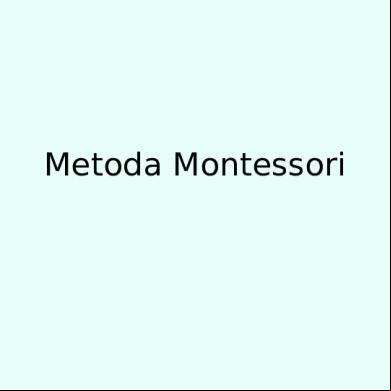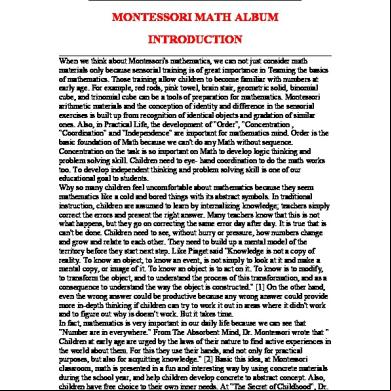Montessori Education 1s4d13
This document was ed by and they confirmed that they have the permission to share it. If you are author or own the copyright of this book, please report to us by using this report form. Report 3b7i
Overview 3e4r5l
& View Montessori Education as PDF for free.
More details w3441
- Words: 305
- Pages: 1
Montessori Education
Traditional Education
Based on helping the natural development of the human being
Based on the transfer of a national curriculum
Children learn at their own pace and follow their own individual interest
Children learn from a set curriculum according to a time frame that is the same for everyone
Children teach themselves using materials specially prepared for the purpose
Children are taught by the teacher
Child is an active participant in learning
Child is a ive participant in learning
Understanding comes through the child’s own experiences via the materials and the promotion of children’s ability to find things out for themselves
Learning is based on subjects and is limited to what is given
Learning is based on the fact that physical exploration Children sit at desks and learn from a and cognition are linked whiteboard and worksheets Child can work where he/she is comfortable, move around and talk at will while not disturbing others
Child is usually assigned own chair and encouraged to sit still and listen during group sessions
The teacher works in collaboration with the children
The class is teacher led
The child’s individual development brings its own reward and therefore motivation
Motivation is achieved by a system of reward and punishment
Environment and method encourage internal self-‐ discipline
Teacher acts as primary enforcer of external discipline
Child works as long as he/she wishes on chosen project
Child generally given specific time limit for work
Uninterrupted work cycles
Block time, period lessons
Mixed age groups
Same age groups
Working and learning matched to the social development of the child
Working and learning without emphasis on the social development of the child
Shared emphasis on intellectual, social, emotional and Main emphasis on intellectual development spiritual development Shared focus on the acquisition of academic, social, practical and life skills
Main focus on academics
Traditional Education
Based on helping the natural development of the human being
Based on the transfer of a national curriculum
Children learn at their own pace and follow their own individual interest
Children learn from a set curriculum according to a time frame that is the same for everyone
Children teach themselves using materials specially prepared for the purpose
Children are taught by the teacher
Child is an active participant in learning
Child is a ive participant in learning
Understanding comes through the child’s own experiences via the materials and the promotion of children’s ability to find things out for themselves
Learning is based on subjects and is limited to what is given
Learning is based on the fact that physical exploration Children sit at desks and learn from a and cognition are linked whiteboard and worksheets Child can work where he/she is comfortable, move around and talk at will while not disturbing others
Child is usually assigned own chair and encouraged to sit still and listen during group sessions
The teacher works in collaboration with the children
The class is teacher led
The child’s individual development brings its own reward and therefore motivation
Motivation is achieved by a system of reward and punishment
Environment and method encourage internal self-‐ discipline
Teacher acts as primary enforcer of external discipline
Child works as long as he/she wishes on chosen project
Child generally given specific time limit for work
Uninterrupted work cycles
Block time, period lessons
Mixed age groups
Same age groups
Working and learning matched to the social development of the child
Working and learning without emphasis on the social development of the child
Shared emphasis on intellectual, social, emotional and Main emphasis on intellectual development spiritual development Shared focus on the acquisition of academic, social, practical and life skills
Main focus on academics





